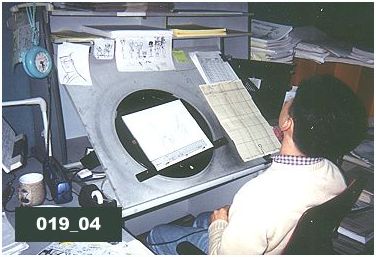cataroo.com
Home of John Cawley
Dedicated to My Wife & Times - A Site for Sore Eyes
Back To Archives
Back To Main Page
|
Frames of Time... 019_04 - Animating in Korea This shot, of an animator sleeping at his desk, is probably what folks think about when overseas animation studios are brought up. The cliche of dozens of artists crammed into sweatshops is a long standing one. Having gone to Korea several times, as well as Japan and Taiwan, I can say that most studios overseas are about the same as those in this country. The studios in the East are mostly in standard business districts of their city. They feature offices, bullpens and such. Key artists and execs often have their own offices. Others are in cubes or grouped in large areas. The biggest differences are payment and actual staffing. When it comes to pay, most of the artists still work under a footage rate. Due to this, there is a desire to become very fast at whatever task you choose. This dedication to speed is one reason a small staff can produce 13 half hours in one year. Animators can sometimes produce over 100 feet a week. In comparison, U.S. animators can producer around 10-15 feet per week. That is why most U.S. feature studios can only produce 2-3 half hours per year. There are some exceptions. Famed Mickey Mouse animators Ub Iwerks and Fred Moore are reported to do over 60 feet of Mouse animation a week. In the 1980s, it is known that Don Bluth, John Pomeroy and Richard Williams could each produce over 50 feet of animation a week when needed! As for staff, most overseas studios keep a small staff actually in the building. They frequently freelance out work to additional animators and even smaller studios. On a recent trip to Korea, we found at least a half doze studios all working on the same U.S. TV series. Upon questioning, we found only two were actually hired by the U.S. studio. Again, this is not uncommon in the U.S. When the animation became late on WHO FRAMED ROGER RABBIT, Disney utilized an outside studio to handle much of the Toon Town sequence. Also, features like FERN GULLY were actually animated by numerous studios as Fox and the Kroyers sent sequences around the world for completion. Of course the biggest difference between U.S. studios and their Eastern counterparts is in the pay department. Artists and staff in Korea, Japan and Taiwan make less than their U.S. counterparts. However, that does not lessen many artists desire to improve. In fact, the footage factor, along with the fact that key positions are better paid than others, makes the artists work very hard to improve in both skill and speed.
Back To Archives Back To Main Page |
 Earlier I talked about how the artists and staff at
Earlier I talked about how the artists and staff at